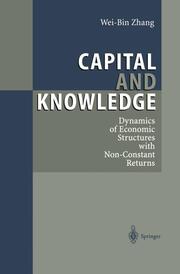Detailansicht
Capital and Knowledge
Dynamics of Economic Structures with Non-Constant Returns
ISBN/EAN: 9783642635168
Umbreit-Nr.: 4368846
Sprache:
Englisch
Umfang: xi, 431 S.
Format in cm:
Einband:
kartoniertes Buch
Erschienen am 08.10.2012
Auflage: 1/1999
- Zusatztext
- InhaltsangabeIntroduction: Classical Economics.- General Equilibrium Theory.- Neoclassical Growth Theory.- Disequilibrium Economics.- Economic Structure.- Economics with Returns to Scale.- Modern Vision of Economic Processes by Complex Theory.- Structure of the Study.- One-Sector Growth Models under Constant Returns to Scale: The One-Sector Growth Model.- Growth with Home Capital.- Time Distribution in the One-Sector Growth Model.- Conclusions.- Appendix.- Production Functions in Growth Theory.- Preference and Utility Functions.- The Solow-Swan Model.- The Ramsey Growth Model.- One-Sector Economies under Non-Constant Returns to Scale: The Growth Model with Public Goods.- Knowledge, Population, Environment and Economic Growth.- An Economic Dynamics with Livestock.- Economic Development with Human Capital and Opening.- On Returns to Scale.- Appendix.- Economic Growth with Money.- Economic Chaos with Endogenous Population.- Knowledge, Growth and Economic Structures: An Agricultural Economy with Land Ownership Distribution.- A Two-Sector Recardian Economy.- The Ricardian System with Knowledge and Infrastructures.- A Structural Dynamics of Agriculture, Industry and Service.- Economic Structure with Multiple Capital Goods.- On Economic Structures.- Appendix.- The Neoclassical Two-Sector Growth Model.- The Neoclassical Multiple Sector Models.- Proving Proposition 4.2.1.- Proving Proposition 4.4.1.- Proving Proposition 4.5.1.- Knowledge, Growth and Wealth Distribution: Income Distribution with Human Capital, Diligence and Frugality.- Growth with Government`s Redistribution Policy.- Economic Structure with Multiple Groups and Job Amenities.- A Two-Group Growth Model with Capital and Knowledge.- On Economic Evolution with Multiple Groups.- Appendix.- Distribution of Income and Wealth in Sato`s Model.- Proving Propositions 5.1.1 and 5.1.2.- Proving Proposition 5.3.1.- Proving Proposition 5.4.1.- Education, Research and Growth: Education and Saving in the Growth Model.- The Research Model with Job Amenities.- The Two-Group Model with Research and Job Amenities.- Growth with Capital, Human Capital and Knowledge.- Appendix.- Proving Proposition 6.1.1.- Unemployment in Disequilibrium Dynamics: Growth and Unemployment in a Two-Group-Economy.- Unemployment with Endogenous Knowledge.- Unemployment in a 'Welfare Economy'.- Conclusions.- Appendix.- Proving Lemmas 7.1.3 and 7.1.4 and Examining the Case of Different Preferences.- Proving Proposition 7.2.1.- Economic Development with Sexual Division of Labor: Sexual Division of Labor with Home Capital and Time Distribution.- The Impact of Female Labor Participation on Knowledge Economies.- Sexual Division of Labor with Capital and Knowledge.- Economic Growth with Sexual Discrimination.- On Complex of Sexual Division of Labor and Consumption.- Appendix.- Proving Lemmas 8.1.3 and 8.1.4.- Proving Lemma 8.2.1.- Proving Propositions 8.3.1 and 8.3.2.- Preference Change with Capital and Knowledge: Preference Change in the One-Sector Growth Model.- Dynamics of Knowledge, Capital and Preference.- Dynamic Economic Structure with Preference Change.- Growth and Preference Change with Sexual Division of Labor.- Concluding Remarks.- Summary.
- Kurztext
- The author tries to combine different economic theories to a new theory that can explain economic phenomena which cannot be explained by traditional works
- Autorenportrait
- InhaltsangabeIntroduction: Classical Economics.- General Equilibrium Theory.- Neoclassical Growth Theory.- Disequilibrium Economics.- Economic Structure.- Economics with Returns to Scale.- Modern Vision of Economic Processes by Complex Theory.- Structure of the Study.- One-Sector Growth Models under Constant Returns to Scale: The One-Sector Growth Model.- Growth with Home Capital.- Time Distribution in the One-Sector Growth Model.- Conclusions.- Appendix.- Production Functions in Growth Theory.- Preference and Utility Functions.- The Solow-Swan Model.- The Ramsey Growth Model.- One-Sector Economies under Non-Constant Returns to Scale: The Growth Model with Public Goods.- Knowledge, Population, Environment and Economic Growth.- An Economic Dynamics with Livestock.- Economic Development with Human Capital and Opening.- On Returns to Scale.- Appendix.- Economic Growth with Money.- Economic Chaos with Endogenous Population.- Knowledge, Growth and Economic Structures: An Agricultural Economy with Land Ownership Distribution.- A Two-Sector Recardian Economy.- The Ricardian System with Knowledge and Infrastructures.- A Structural Dynamics of Agriculture, Industry and Service.- Economic Structure with Multiple Capital Goods.- On Economic Structures.- Appendix.- The Neoclassical Two-Sector Growth Model.- The Neoclassical Multiple Sector Models.- Proving Proposition 4.2.1.- Proving Proposition 4.4.1.- Proving Proposition 4.5.1.- Knowledge, Growth and Wealth Distribution: Income Distribution with Human Capital, Diligence and Frugality.- Growth with Government`s Redistribution Policy.- Economic Structure with Multiple Groups and Job Amenities.- A Two-Group Growth Model with Capital and Knowledge.- On Economic Evolution with Multiple Groups.- Appendix.- Distribution of Income and Wealth in Sato`s Model.- Proving Propositions 5.1.1 and 5.1.2.- Proving Proposition 5.3.1.- Proving Proposition 5.4.1.- Education, Research and Growth: Education and Saving in the Growth Model.- The Research Model with Job Amenities.- The Two-Group Model with Research and Job Amenities.- Growth with Capital, Human Capital and Knowledge.- Appendix.- Proving Proposition 6.1.1.- Unemployment in Disequilibrium Dynamics: Growth and Unemployment in a Two-Group-Economy.- Unemployment with Endogenous Knowledge.- Unemployment in a 'Welfare Economy'.- Conclusions.- Appendix.- Proving Lemmas 7.1.3 and 7.1.4 and Examining the Case of Different Preferences.- Proving Proposition 7.2.1.- Economic Development with Sexual Division of Labor: Sexual Division of Labor with Home Capital and Time Distribution.- The Impact of Female Labor Participation on Knowledge Economies.- Sexual Division of Labor with Capital and Knowledge.- Economic Growth with Sexual Discrimination.- On Complex of Sexual Division of Labor and Consumption.- Appendix.- Proving Lemmas 8.1.3 and 8.1.4.- Proving Lemma 8.2.1.- Proving Propositions 8.3.1 and 8.3.2.- Preference Change with Capital and Knowledge: Preference Change in the One-Sector Growth Model.- Dynamics of Knowledge, Capital and Preference.- Dynamic Economic Structure with Preference Change.- Growth and Preference Change with Sexual Division of Labor.- Concluding Remarks.- Summary.
